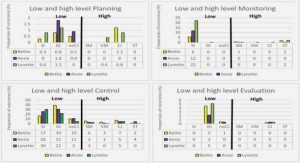Get Complete Project Material File(s) Now! »
Carbon capture and storage: the process
In general, CCS is a process composed of several stages: carbon dioxide capture and separation from industrial and energy-related sources, transportation to a storage location and long-term isolation from the ambient air in geological formations, in the oceans, or as carbonate minerals [22]. CO2 capture, separation and storage techniques should be distinguished: pre-, oxy- and post-combustion as uptake methods; absorption (amines, carbonates, ammonia, and limestone), adsorption (metal organic frameworks and zeolites), membranes (fibers and microporous), biological (algae and cyanobacteria) as separation techniques; and geological, ocean and mineral sequestration as storage methods (Fig. 1.2) [23, 24, 25].
More and more companies are choosing the way to “zero” emissions or at least to reduce their carbon footprint by applying various CO2 trapping and separation techniques to optimize the technological process [26]. Following the capture step, gas is compressed and transported to appropriate storage location [27]. Geological storage options include an Enhanced Oil Recovery (EOR), Enhanced Coal-Bed Methane (ECBM) recovery, and saline aquifers injection [28]. But, unfortunately, the abovementioned techniques provide only short-term storage in geological scale and cannot be left unsupervised. Ocean storage seems challenging due to the increasing ocean acidification and marine life depletion as a result of CO2 injection directly into the ocean [29].
Thus, among the variety of storage options, carbon mineralization appears the most stable and environmentally benign technique that can be successfully applied all over the world. Since the possibility of safe and long-term storage is a crucial issue, mineral sequestration has been receiving an increasing attention as an efficient method of CCS [30].
Carbon mineralization
Different methods of carbon capture and storage from the ambient air as well as directly from industrial sources have been researched and developed recently [31]. While geologic and ocean sequestrations allow storage of CO2 in large quantities, high operation costs along with a cost of transportation and negative environmental impact emphasizes the need for more mature technologies [32]. As a result, much attention has been recently paid to the mineral carbonation or weathering as well as utilization of captured CO2 in industrial materials production [33]. Numerous technological routes for carbon sequestration by various minerals have been investigated to date [34]. The diversity of methods directly depends on the way of the process performing such as ex-situ which represents aboveground carbonation of naturally occurring Mg-based silicates and industrial wastes via mineral carbonation plant, in-situ where CO2 is injected into rocks formations or residues (Fig. 1.3). There is a third technique of carbon capture which does not require any external help in gas trapping and called a passive carbonation method where CO2 is captured naturally by various mine tailings as well as rocks [35, 36].
Currently, the research in carbon mineralization has largely focused on ex-situ and in-situ carbonation processes which is broadly exposed in the literature [23]. The principal distinction from passive mineralization is the presence of accelerators such as elevated temperature and high pressure (e.g., 185°C, 150 atm) [37]. Unlike aforementioned methods, natural passive carbonation takes place at atmospheric CO2 concentration, pressure, and temperature and has been documented all over the world [38, 39, 40].
Mineral carbonation technology first was proposed by Seifritz in 1990 and the initial idea of this method is to simulate a natural phenomenon called weathering which principally represents a thermodynamically favorable reaction between silicate minerals with high magnesium (Mg) content and gaseous CO2 [41, 42]. There are several advantages that make mineral carbonation a viable process and motivate further investigations [43]. Firstly, the process naturally occurs and products of the reaction are a thermodynamically stable carbonates that have benign environmental impact [44]. Secondly, the capacity for large scale sequestration owing to Mg-rich minerals are widely available globally as relatively low-cost feedstock [45]. Finally, the process provides significant heat due to the exothermal behavior (R1.1-1.3) of ongoing reactions and hence it gives the potential for economic viability [20].
Direct gas-solid mineral carbonation has been receiving much less attention after Lackner research work in 1995 that investigated “wet” carbonation and recognized the gas-solid method as unviable due to it too slow carbonation rate and high energy consumption [46]. Direct one-step aqueous carbonation technology produces high–purity carbonates at the expense of high severity conditions such as high temperature and up to supercritical CO2 pressure which adversely affect the method economic viability [47]. Reactivity evolution was examined and has shown the importance of the presence of water in the pores. Since CO2 gas is soluble, it dissolves in porous water and provides the acidification required for leaching the material before the reaction develops between the aqueous carbonate ions and the basic metal cations [48, 49, 20, 21].
In the process of developing the idea of mineral sequestration, mining tailings, due to their availability and abundance, low cost, and a larger surface area, very quickly attracted the attention of various researchers [49, 50, 38]. Along with carbon emission mitigation policy emerged a demand to reduce the cost of CCS and, as a result, the use of lower temperatures and pressures close to ambient conditions that would consume less energy [51]. By far, sequestration kinetics, carbonation potential, water saturation of the material, products mineralogy, and temperature impact on the process were examined under environmental conditions by various research groups over the world [38, 48, 52, 53, 54, 55].
However, passive mineral sequestration suffers from a couple of drawbacks such as low intrinsic reaction rates in comparison with active mineral carbonation and the challenge to control the process under ambient conditions [49].
Summing up all aforesaid, the main advantage of mineral sequestration over other methods is the stable carbonates formation that permanently preserves carbon over geological time scale without risk of CO2 leakage back into the atmosphere [56].
Feedstock
Magnesium is the eighth most abundant element in the Earth’s crust by mass. Depending on the 60+ naturally occurring Mg-bearing minerals, it is a more or less reactive when it comes to CO2 capture [57]. Nevertheless, magnesium silicates are favorable for carbon sequestration owing to their high abundance over the globe (Fig. 1.4) [31]. However, Mg-bearing alkaline industrial wastes, particularly mafic and ultramafic mining tailings, are used much more often than alkaline rocks by reason of fine particle size that as a result provides bigger reactive surface and greater reactivity in comparison to other silicate minerals [55].
By virtue of large amounts of mines all over the world and notably in Canada, mining residues became a widely utilized feedstock for permanent CCS [36]. Abundance of the material for CO2 sequestration is sufficient to capture substantial proportions from the carbon already accumulated in current atmosphere for the decades ahead [58].
Figure 1.4 Location of ultra(mafic) rocks lying in the immediate vicinity (less than 300 km) from a CO2-emission plant [56].
Mining tailings composition greatly varies and depends on the ore mineralogy and often consists of up to 20 wt. % Mg primarily in form of silicates [59]. In Quebec region mining tailings are represented as by-products after extraction and recovery of nickel as a valuable metal [60]. The mining residues composition can be generally presented by several mineral groups: serpentine ((Mg,Fe)3Si2O5(OH)4) which can be found in nature in form of several polymorphs – lizardite, chrysotile, antigorite; olivine ((Mg, Fe)2SiO4) and its Mg-dominant member forsterite, and brucite (Mg(OH)2) (Table 1.1) [52, 48]. Mg-rich olivine and serpentine are relatively much more common than Fe-bearing [52].
The Quebec province is considered to be one of the main regions for the natural carbon mineralization due to the broad amount of feedstock for a passive carbon capture and storage [49, 38]. There are several regional mining sites with different brucite content. Black Lake Mine, Thetford Mines contains mainly lizardite and chrysotile with traces of brucite. Whereas Dumont Project, Royal Nickel Corporation has up to 11% of brucite with lizardite and chrysotile as main components [55, 61].
Process principles and reaction products
MgCO3 is the most desirable product of sequestration due to the lowest solubility and as a result highest stability over geological time scales [62, 63]. General reaction of CO2 uptake with formation of geologically stable carbonates can be represented as [64]: MgxSiyOx+2y+ xCO2 = xMgCO3 + ySiO2 (R1.4)
Unfortunately, from the chemical standpoint the reaction rate of the naturally occurring gas-solid process is very slow which leads to use of high temperature and pressure as acceleration factors to form MgCO3 as a product [65]. On industrial site, the process of CO2 uptake by mine wastes with precipitation of MgCO3 occurs in one step or as a multi-step process, also known as direct and indirect carbonation, respectively [66]. Simultaneous implementation of magnesium extraction from the mineral matrix and CO2 dissolution and carbonate formation in the same reactor is referred to as direct carbonation [67]. A one-step process takes place in either dry or aqueous medium under high pressure and can be illustrated as single reaction with serpentine or olivine (R1.5, R1.6) [68]:
Mg3Si2O5(OH)4 + 3CO2 → 3MgCO3 + 2SiO2 + 2H2O (R1.5)
Mg2SiO4+ 2CO2 → 2MgCO3 + SiO2 (R1.6)
From the point of further utilization, the challenge with direct carbonation is that the process cannot provide high purity carbonates and silica due to the different reaction conditions that are required for every step (mineral and CO2 dissolution, carbonate precipitation), limiting their application [69].
Table of contents :
Chapter I Introduction and scope of the project
1.1. Global warming and carbon footprint
1.2. Carbon capture and storage: the process
1.3. Carbon mineralization
1.4. Feedstock
1.5. Process principles and reaction products
1.6. Carbon mineralization by brucite
1.7. Infrared thermography
1.8. Objectives
1.9. References
Chapter II Research article: Observations of Brucite Thermochemical Carbonation Effects Using Passive Infrared Thermography
Résumé
Abstract
2.1. Introduction
2.2. Materials and methods
2.3. Image post-processing
2.4. Results and discussion
2.4.1. Intrinsic carbonation rate and specific heat generation rate
2.4.2. Infrared thermography of brucite carbonation
2.4.3. Temperature history in reactive and reference half-cells
2.4.4. Heat balance analysis
2.5. Conclusion
2.6. References
Chapter III Thesis Conclusion and Recommendations
3.1. General conclusions
3.2. Future scope of work
Appendix A
Appendix B





